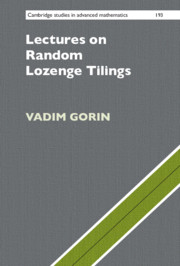Refine search
Actions for selected content:
3023 results in Probability theory and stochastic processes
21 - Lecture 21: Discrete Log-Gases
-
- Book:
- Lectures on Random Lozenge Tilings
- Published online:
- 31 August 2021
- Print publication:
- 09 September 2021, pp 173-184
-
- Chapter
- Export citation
5 - Lecture 5: Monotonicity and Concentration for Tilings
-
- Book:
- Lectures on Random Lozenge Tilings
- Published online:
- 31 August 2021
- Print publication:
- 09 September 2021, pp 42-47
-
- Chapter
- Export citation
Index
-
- Book:
- Lectures on Random Lozenge Tilings
- Published online:
- 31 August 2021
- Print publication:
- 09 September 2021, pp 237-248
-
- Chapter
- Export citation
10 - Lecture 10: Explicit Formulas for Limit Shapes
-
- Book:
- Lectures on Random Lozenge Tilings
- Published online:
- 31 August 2021
- Print publication:
- 09 September 2021, pp 77-85
-
- Chapter
- Export citation
13 - Lecture 13: Ergodic Gibbs Translation-Invariant Measures
-
- Book:
- Lectures on Random Lozenge Tilings
- Published online:
- 31 August 2021
- Print publication:
- 09 September 2021, pp 102-112
-
- Chapter
- Export citation
16 - Lecture 16: Bulk Local Limits for Tilings of Hexagons
-
- Book:
- Lectures on Random Lozenge Tilings
- Published online:
- 31 August 2021
- Print publication:
- 09 September 2021, pp 126-134
-
- Chapter
- Export citation
25 - Lecture 25: Sampling Random Tilings
-
- Book:
- Lectures on Random Lozenge Tilings
- Published online:
- 31 August 2021
- Print publication:
- 09 September 2021, pp 224-236
-
- Chapter
- Export citation
24 - Lecture 24: Discrete Gaussian Component in Fluctuations
-
- Book:
- Lectures on Random Lozenge Tilings
- Published online:
- 31 August 2021
- Print publication:
- 09 September 2021, pp 207-223
-
- Chapter
- Export citation

Lectures on Random Lozenge Tilings
-
- Published online:
- 31 August 2021
- Print publication:
- 09 September 2021
6 - Range and Support of a Measure
-
- Book:
- Counterexamples in Measure and Integration
- Published online:
- 27 May 2021
- Print publication:
- 17 June 2021, pp 123-137
-
- Chapter
- Export citation
12 - Convergence Theorems
-
- Book:
- Counterexamples in Measure and Integration
- Published online:
- 27 May 2021
- Print publication:
- 17 June 2021, pp 235-246
-
- Chapter
- Export citation
14 - Integration and Differentiation
-
- Book:
- Counterexamples in Measure and Integration
- Published online:
- 27 May 2021
- Print publication:
- 17 June 2021, pp 261-279
-
- Chapter
- Export citation
User’s Guide
-
- Book:
- Counterexamples in Measure and Integration
- Published online:
- 27 May 2021
- Print publication:
- 17 June 2021, pp xxv-xxvii
-
- Chapter
- Export citation
11 - Modes of Convergence
-
- Book:
- Counterexamples in Measure and Integration
- Published online:
- 27 May 2021
- Print publication:
- 17 June 2021, pp 221-234
-
- Chapter
- Export citation
List of Topics and Phenomena
-
- Book:
- Counterexamples in Measure and Integration
- Published online:
- 27 May 2021
- Print publication:
- 17 June 2021, pp xxviii-xxx
-
- Chapter
- Export citation
16 - Product Measures
-
- Book:
- Counterexamples in Measure and Integration
- Published online:
- 27 May 2021
- Print publication:
- 17 June 2021, pp 295-316
-
- Chapter
- Export citation
3 - Riemann Is Not Enough
-
- Book:
- Counterexamples in Measure and Integration
- Published online:
- 27 May 2021
- Print publication:
- 17 June 2021, pp 55-72
-
- Chapter
- Export citation
2 - A Refresher of Topology and Ordinal Numbers
-
- Book:
- Counterexamples in Measure and Integration
- Published online:
- 27 May 2021
- Print publication:
- 17 June 2021, pp 36-54
-
- Chapter
- Export citation
7 - Measurable and Non-Measurable Sets
-
- Book:
- Counterexamples in Measure and Integration
- Published online:
- 27 May 2021
- Print publication:
- 17 June 2021, pp 138-163
-
- Chapter
- Export citation
Contents
-
- Book:
- Counterexamples in Measure and Integration
- Published online:
- 27 May 2021
- Print publication:
- 17 June 2021, pp v-xxii
-
- Chapter
- Export citation
